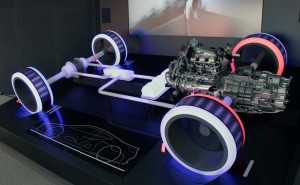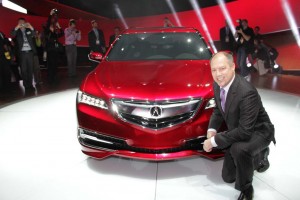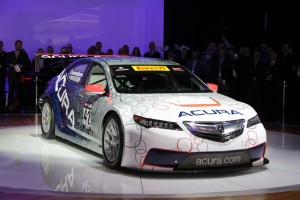Considering the cost of bringing a car to market, every new vehicle is important, but few more so than the 2014 Acura TLX making its first public appearance at the New York Auto Show this week.
Acura has scored a pair of solid hits with its two SUV models, the RDX and bigger MDX, but as the third sedan in the Acura line-up, the TLX is meant to fill a critical gap between the Japanese maker’s entry-level ILX and its recently added flagship, the RLX. It’s no easy challenge, going up against a range of major competitors such as the Mercedes-Benz E-Class, BMW 5-Series and Lexus GS lines.
The TLX is “critically important,” suggests Mike Accavitti, the long-time Chrysler executive who was recently named head of the Acura division. “We have to start somewhere,” he adds.”
In years past, that might have been a modestly important position, largely limited to overseeing the Japanese brand’s marketing efforts. But after years of struggling to get Acura taken seriously as a true, Tier I luxury brands, parent Honda Motor Co. has decided to take more drastic measures, all but spinning Acura off as an independent operation, giving it far more flexibility to develop products that, Accavitti stresses, are no longer just fancier versions of products also found in Honda showrooms.

This mock-up shows the basic layout of the Acura NSX powertrain, including the two motors up front. A third is mated with a rear-mounted turbo V-6.
“Getting tossed the keys to a brand is a very special moment (that) doesn’t happen very often in this business,” Accavitti concedes, during a conversation behind the Acura stand at the NY show.
(Click Here for more on the Acura TLX.)
Acura posted a modest 5.9% increase in sales in 2013, slightly down from the Honda brand’s 7.4% jump and well under the overall industry pace. Even then, the brand was largely dependent upon those two SUV models, the RDX, in particular, setting a sales record last year. The ILX and RDX models, industry analysts contend, have so far failed to generate the sort of market excitement Acura had hoped for.
That said, “There’s nothing wrong with this brand,” Accavitti is quite to argue, though he readily acknowledges it’s time for Acura to make some major changes.
If anything, the new TLX might be seen as sort of a mid-life model for the brand. It’s clearly more stylish than some of Acura’s older products, particularly the staid ILX that critics contend missed its youthful target audience with an older, staid design. But the TLX may eventually look bland itself, if Acura pushes forward with the sort of changes Accavitti is calling for.
(For more on the new plan to separate Honda and Acura, Click Here.)
A critical indicator of what’s to come will make its debut in less than a year, when the all-new NSX sports car makes it into production – a vehicle describes as the brand’s “trump card.” Acura has been building interest since first revealing a concept version of the NSX at the 2012 Detroit Auto Show. But as dynamic as its design might be, the sports car underscores the other critical element of Acura’s new strategy, a focus on bringing to market useful and distinctive technologies such as Super-Handling All-Wheel-Drive.
Known by the abbreviation, SH-AWD, it’s been offered in a number of models in recent years and is based on a modified all-wheel-drive system that not only can manage icy or rough roads but which can direct torque in a way that improves handling in tight corners.
The current system relies on brake intervention, essentially braking the inside wheels in a corner. But the newest version – which will be offered on the NSX, as well as the MDX and RDX models — relies on a unique, three-motor hybrid system that is more elegant and effective.
And that’s just one of many technical innovations Acura is planning to bring out over the next several years. It has an assortment of new engines, including turbocharged powertrains that make significant amounts of power despite their relatively small displacements. There’s also a new system that can help a vehicle maintain its position within a lane, even if the driver gets distracted and inadvertently starts to drift across the yellow lines.
(Korea’s Kia also moving into luxury segment with premium K900 sedan. Click Here for a look.)
Relying on technology to differentiate a brand is a challenge, Accavitti recognizes. What debuts in a luxury model for 2015 could show up in a mainstream product a year or two later, he concedes, noting that, “The half-life of technology is half what it used to be.” But Acura is betting that it will be more difficult for competitors to copy the SH-AWD system, especially the version based on a hybrid-electric drivetrain, like what will be offered with the NSX.
When it was launched in early 1986, Acura was the first Japanese luxury brand. It made an early name for itself with products like the Legend and Integra. But by the early ‘90s, it had lost momentum to Japanese competitors such as the newer Lexus, never mind traditional luxury marques such as Mercedes.
“The luxury world has changed since this brand was formed,” says Accavitti, noting Acura will have to catch up on many of those changes.
One of the biggest changes has been the rapid proliferation of new models. Mercedes alone plans to launch 30 all-new or completely revamped products this decade, one every quarter. “We always look for white space where we can make a positive impact,” says Acura’s new boss, though he doesn’t expect to come close to matching the Germans’ product cadence.
Whenever the subject of Acura comes up, so does the question of its quirky model nomenclature. Even its fans have trouble remembering which vehicle is which. It might make sense for a TLX to be higher in the rankings than an ILX, but why is an RLX the marque’s top-line model? Accavitti doesn’t deny the decision to drop the well-known Legend nameplate for an alphanumeric approach was, well, questionable. But, for now, Acura isn’t going back.
It’s putting its longer-term focus on new products that will be ever more distinctive as it puts some distance between itself and sibling Honda. The more immediate goal is “to get butts in seats,” the executive says, insisting that even Acura’s older models are more fun to drive than potential buyers realize. The short-term challenge is simply to get motorists into showrooms for a test drive.


